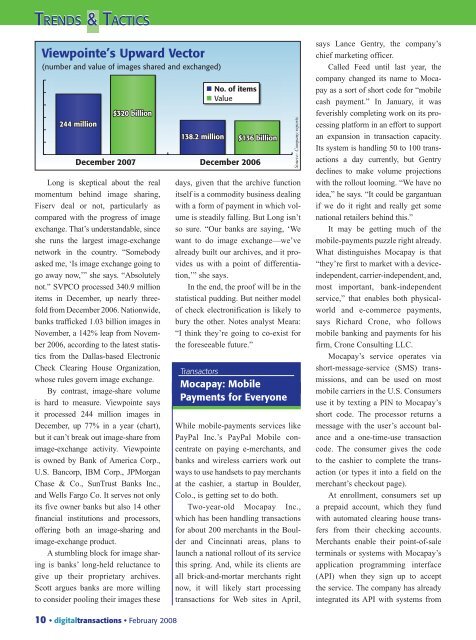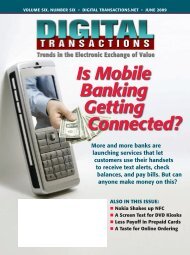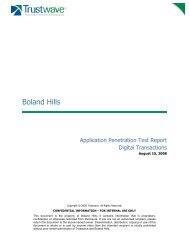The Broken Link - Digital Transactions
The Broken Link - Digital Transactions
The Broken Link - Digital Transactions
Create successful ePaper yourself
Turn your PDF publications into a flip-book with our unique Google optimized e-Paper software.
TRENDS & TACTICS<br />
TRENDS & TACTICS<br />
Viewpointe’s Upward Vector<br />
(number and value of images shared and exchanged)<br />
244 million<br />
$320 billion<br />
Long is skeptical about the real<br />
momentum behind image sharing,<br />
Fiserv deal or not, particularly as<br />
compared with the progress of image<br />
exchange. That’s understandable, since<br />
she runs the largest image-exchange<br />
network in the country. “Somebody<br />
asked me, ‘Is image exchange going to<br />
go away now,’” she says. “Absolutely<br />
not.” SVPCO processed 340.9 million<br />
items in December, up nearly threefold<br />
from December 2006. Nationwide,<br />
banks trafficked 1.03 billion images in<br />
November, a 142% leap from November<br />
2006, according to the latest statistics<br />
from the Dallas-based Electronic<br />
Check Clearing House Organization,<br />
whose rules govern image exchange.<br />
By contrast, image-share volume<br />
is hard to measure. Viewpointe says<br />
it processed 244 million images in<br />
December, up 77% in a year (chart),<br />
but it can’t break out image-share from<br />
image-exchange activity. Viewpointe<br />
is owned by Bank of America Corp.,<br />
U.S. Bancorp, IBM Corp., JPMorgan<br />
Chase & Co., SunTrust Banks Inc.,<br />
and Wells Fargo Co. It serves not only<br />
its five owner banks but also 14 other<br />
financial institutions and processors,<br />
offering both an image-sharing and<br />
image-exchange product.<br />
A stumbling block for image sharing<br />
is banks’ long-held reluctance to<br />
give up their proprietary archives.<br />
Scott argues banks are more willing<br />
to consider pooling their images these<br />
138.2 million<br />
• No. of items<br />
• Value<br />
$136 billion<br />
December 2007 December 2006<br />
days, given that the archive function<br />
itself is a commodity business dealing<br />
with a form of payment in which volume<br />
is steadily falling. But Long isn’t<br />
so sure. “Our banks are saying, ‘We<br />
want to do image exchange—we’ve<br />
already built our archives, and it provides<br />
us with a point of differentiation,’”<br />
she says.<br />
In the end, the proof will be in the<br />
statistical pudding. But neither model<br />
of check electronification is likely to<br />
bury the other. Notes analyst Meara:<br />
“I think they’re going to co-exist for<br />
the foreseeable future.”<br />
Transactors<br />
Mocapay: Mobile<br />
Payments for Everyone<br />
Source: Company reports<br />
While mobile-payments services like<br />
PayPal Inc.’s PayPal Mobile concentrate<br />
on paying e-merchants, and<br />
banks and wireless carriers work out<br />
ways to use handsets to pay merchants<br />
at the cashier, a startup in Boulder,<br />
Colo., is getting set to do both.<br />
Two-year-old Mocapay Inc.,<br />
which has been handling transactions<br />
for about 200 merchants in the Boulder<br />
and Cincinnati areas, plans to<br />
launch a national rollout of its service<br />
this spring. And, while its clients are<br />
all brick-and-mortar merchants right<br />
now, it will likely start processing<br />
transactions for Web sites in April,<br />
says Lance Gentry, the company’s<br />
chief marketing officer.<br />
Called Feed until last year, the<br />
company changed its name to Mocapay<br />
as a sort of short code for “mobile<br />
cash payment.” In January, it was<br />
feverishly completing work on its processing<br />
platform in an effort to support<br />
an expansion in transaction capacity.<br />
Its system is handling 50 to 100 transactions<br />
a day currently, but Gentry<br />
declines to make volume projections<br />
with the rollout looming. “We have no<br />
idea,” he says. “It could be gargantuan<br />
if we do it right and really get some<br />
national retailers behind this.”<br />
It may be getting much of the<br />
mobile-payments puzzle right already.<br />
What distinguishes Mocapay is that<br />
“they’re first to market with a deviceindependent,<br />
carrier-independent, and,<br />
most important, bank-independent<br />
service,” that enables both physicalworld<br />
and e-commerce payments,<br />
says Richard Crone, who follows<br />
mobile banking and payments for his<br />
firm, Crone Consulting LLC.<br />
Mocapay’s service operates via<br />
short-message-service (SMS) transmissions,<br />
and can be used on most<br />
mobile carriers in the U.S. Consumers<br />
use it by texting a PIN to Mocapay’s<br />
short code. <strong>The</strong> processor returns a<br />
message with the user’s account balance<br />
and a one-time-use transaction<br />
code. <strong>The</strong> consumer gives the code<br />
to the cashier to complete the transaction<br />
(or types it into a field on the<br />
merchant’s checkout page).<br />
At enrollment, consumers set up<br />
a prepaid account, which they fund<br />
with automated clearing house transfers<br />
from their checking accounts.<br />
Merchants enable their point-of-sale<br />
terminals or systems with Mocapay’s<br />
application programming interface<br />
(API) when they sign up to accept<br />
the service. <strong>The</strong> company has already<br />
integrated its API with systems from<br />
10 • digitaltransactions • February 2008







